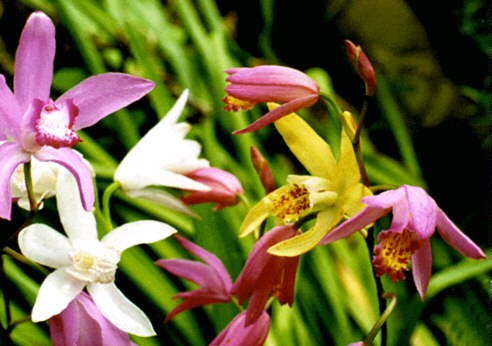

As is the case with epiphytic orchids, a relatively few hardy terrestrial genera hold disproportionate potential for horticultural usefulness. Along with Cypripedium and Calopogon, some of the greatest potential lies in the genus Bletilla. This small genus is represented in cultivation by only three species and their varieties, Bletillas striata, formosana, and ochracea. Of these three, Ble. striata and Ble. ochracea are vigorous and hardy, at least to USDA zone five. Bletilla striata is found in three varieties, the type variety of bright magenta purple, the white variety alba, and a variety with white variegations in the leaves. The purple and white varieties have long been available in the horticultural trade and can often be found for sale in retail garden centers. This "commoner" presentation may, in part, be responsible for the otherwise surprising lack of interest displayed by the orchid community. The species ochracea possesses bright mustard yellow flowers and has recently been introduced into cultivation from western China through the efforts of the National Arboretum and a network of dedicated fanciers. Bletilla ochracea has proven equally hardy to Ble. striata and hybridizes readily with it.
Bletilla striata and its varieties and Bletilla ochracea are very amenable to cultivation. Both do well in bright light in normal quality soil, planted three to four inches deep. In the author's garden in Baltimore, Maryland, USA, in USDA zone 6.5, both species multiply rapidly growing in full sun. They are mulched with two to three inches of pine straw in the Winter to prevent early emergence in the Spring as the growing tips are susceptible to unsightly frost damage. Neither species is fertilized, nor has any fungicide or insecticide ever been used on either species. Under these conditions, the leaves of Ble. ochracea are slightly thinner than Ble. striata and the plants are slightly smaller. Other than these minor differences, the plants are very similar in their presentation. Bletilla ochracea blooms about three weeks later than Ble. striata, though there is plenty of overlap in their two month blooming periods. The racemes of both species yield three to ten flowers and, in good years, many of the racemes will be branched. The hybrid between the two species is intermediate in all respects and is very attractive, combining the bright rose color of the Ble. striata with a graceful presentation and bright yellow disk in the lip from Ble. ochracea. A bundle of Bletillas is lovely and long lasting. One feature which portends a bright future for the genus is the ease with which the Bletilla racemes can be pulled from the plant, eliminating the need for cutting utensils with their attendant risk of virus transmission.
Bletillas grow rapidly by division under good conditions. Most of the commercial Bletilla striata was surely obtained by propagation of a few clones. In addition, they grow with abandon from seed, utilizing any of the popular media or even on dampened Sphagnum moss, though the latter gives a much lower yield. Given good growing conditions, it is not uncommon to bloom seedlings two to three years from pollination. The prospect of rapid generation turnover and resulting selective breeding is very exciting. The author has second generation U.S. bred clones in the garden already under less than optimal seedling care. Other growers in the network are reporting light pink variants among seed-grown Bletilla striata. Attention can now focus on larger flower size and a more upward facing presentation. Bletilla is known to hybridize successfully with Arundina graminifolia (unregistered) and attempts are being made to cross it with the taxonomically related genus Calanthe, thus far with no reported success. The introduction of other species of Bletilla would be desirable.
Registered hybrids
Bletilla striata x formosana = Yokohama (N. Suzuki 1956)
Bletilla formosana x ochracea = Coritani (R. Evenden 1994)
Bletilla striata x ochracea = Brigantes (R. G. & A. Evenden 1994)
* an original article by Clark T. Riley
Permission is given for reprinting. No changes may be made without the permission of the author, drriley@mypcr.com, please. Electronic mail queries welcome for additional illustrations.